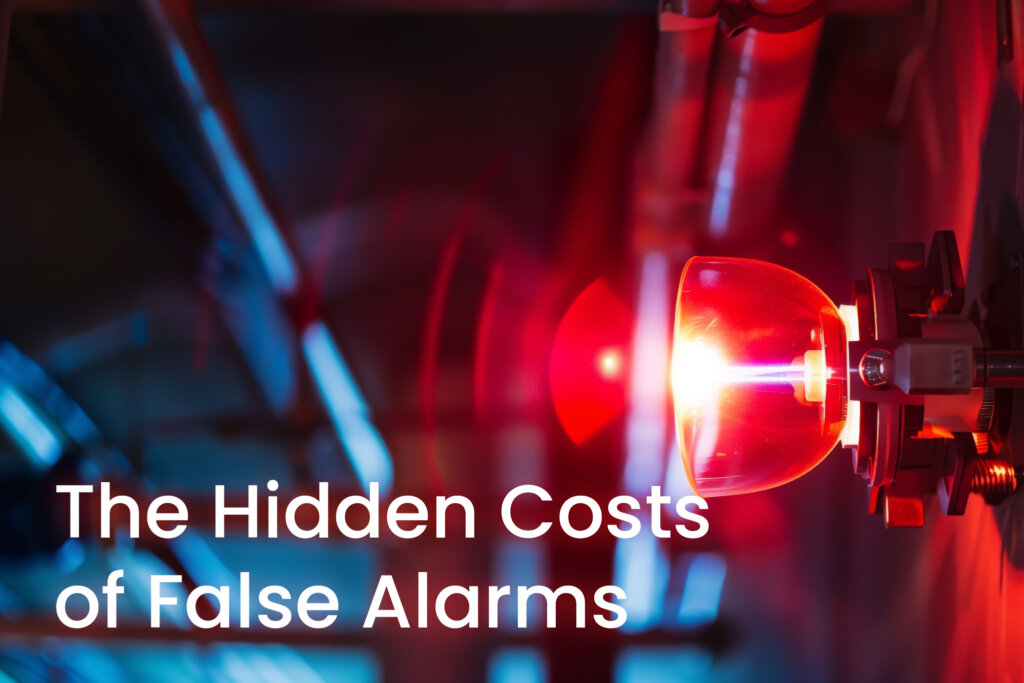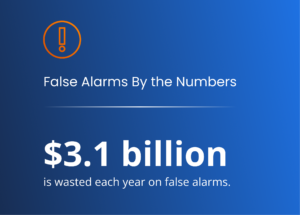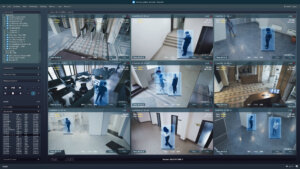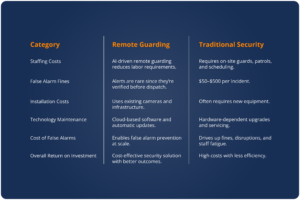The Hidden Costs of False Alarms: Why Virtual Guards Are the Solution

The cost of false alarms impacts everyone, from business owners to public safety organizations, particularly those relying on traditional, outdated security systems.
Whether caused by faulty motion detectors, aging glass break sensors, or even simple human error, these false activations waste valuable time and resources.
Up to 99% of all security system alarms are false, forcing local law enforcement to respond unnecessarily. For businesses, that can mean thousands of dollars annually in fines. That’s beside the strain on internal staff and emergency services.
This article explores the real cost of false alarms and why they happen so often. We’ll explore why traditional security systems fall short—and what makes virtual guarding a smarter choice.
A False Security Alarm Costs More Than You Think
Motion sensors, human error, and misconfigured surveillance setups are the cause of most security system false alarms.
But they’re more common—and more expensive—than most people realize.
Numerous studies have shown that between 90% and 99% of all security alarms are false. That’s about 62 million false alarms each year, costing a whopping $3.1 billion.
But the cost of false alarms goes way beyond economics.
They’re also a major strain on resources, relationships with local law enforcement agencies, and public safety organizations.
Fees and Penalties
False alarms aren’t free. Most cities charge anything between $50 and $500 per incident after the first one. Some areas impose tiered penalties, where more false alarms equate to higher fees. Businesses and organizations can rack up thousands in penalties, especially with outdated or faulty surveillance and security systems.
Strain on Emergency Resources
Each false alarm diverts law enforcement, fire, or EMS from real emergencies. This slows response times for actual threats and puts lives at risk.
Business Disruption
False alerts cause evacuations, lockouts, or system resets. These issues, in turn, lead to lost productivity, operational downtime, frustrated employees, and diminished customer service.
Reputational Damage
Too many false dispatches can harm your reputation with local law enforcement and your community. Vendors, tenants, and customers may lose confidence in your security operations.
Erosion of Trust and Alarm Fatigue
False security alarms also contribute to alarm fatigue and desensitization. Security teams, emergency services, and law enforcement may deprioritize alerts, which increases risk for real threats or incidents. This weakens the effectiveness of your entire security setup.
This effect isn’t limited to responders, either. For example, one study of ICU nurses found that constant false alarms caused psychological stress, desensitization, and slower reaction times.
Increased Risk of Accidents
Every false security alarm creates chaos. People rush, panic, or act without thinking. These situations increase the chance of secondary incidents, like slips, falls, or injuries.
Why Traditional Security Isn’t Solving the Problem
Many organizations still rely on legacy or outdated security solutions.
But those systems don’t stop false alarms—and often, they’re the main cause.
Traditional setups typically use motion detectors, smoke detectors, or basic security cameras linked to home security systems or enterprise networks.
These tools frequently misfire.
Environmental Triggers Are Constant
A passing animal, moving branches, or HVAC airflow can all trigger false alarm activations. In fact, each year Fire and Rescue services respond to thousands of unwanted automatic fire alarm (AFA) alerts. The kicker? They make up 97% of all dispatches.
Even slight lighting changes or reflections near doors and windows can set off basic video motion detection (VMD) systems.
Human Error and Faulty Equipment
Human error and faulty equipment are also major contributors.
Staff might forget to disarm the system or schedule incorrect alerts. That alone accounts for millions of false dispatches every year.
Monitoring Centers Without Context
Moreover, conventional monitoring centers often can’t verify what triggered an alarm. Most security companies rely on basic alerts and phone calls to 911 dispatchers.
There’s no visual context.
This outdated model means decisions are based on limited or incomplete data. Operators are forced to “guess” whether an alarm is real, often erring on the side of caution. But doing so often results in wasted resources for false dispatches.
Real Costs, Reduced Trust
False alarms result in costly fines, delayed emergency responses, staff fatigue, and strained relationships with local law enforcement. Over time, they erode trust in the system and reduce overall safety.
Meanwhile, organizations are left with expensive penalties and ineffective systems that don’t actually reduce false alarms.
Remote Guarding: A Better Approach to False Alarms
Traditional surveillance systems do generate alerts.
But they rarely answer the most important question: Is this real?
Enter remote guarding. Instead of relying on passive sensors, virtual or remote video guarding uses AI to detect real threats in real time.
No more random motion alerts. No more guessing.
Remote guarding software uses AI video analytics to turn existing surveillance cameras into proactive threat detection tools. Suspicious activities like loitering, perimeter breaches, or visible weapons are detected live, not after the fact.
This makes remote guarding one of the most effective alternative security systems available today.
Smarter, Faster Responses
Instead of reacting to every movement, remote guarding software uses AI algorithms to identify real threats and stop crime before it happens. The system then automatically notifies your central monitoring center or security personnel.
This dramatically reduces false security alarms while improving the speed, accuracy, and overall effectiveness of your monitoring services or systems.
24/7 Coverage Without the Gaps
Unlike motion-only systems, AI-powered remote guarding eliminates noise and maximizes focus. It provides 24/7 oversight, closing the gaps left by random patrol routes or passive alarms.
Better Protection and Less Manual Workload
Remote guarding is false alarm prevention at its smartest. It helps businesses protect staff, assets, and operations without hiring more guards or additional manual labor.
It’s a cost-effective, scalable upgrade for companies ready to move beyond outdated systems.
Cost Savings: Virtual vs. Traditional Security
The cost of false alarms adds up quickly. Traditional systems come with hidden expenses: outdated equipment, guard patrols, and fines for false alarm activations. Virtual guarding offers a smarter, more cost-effective security solution.
Here’s how remote guarding compares to traditional models:
Remote guarding is a strategic investment. It helps businesses cut costs, reduce risk, and get more from their security services without adding complexity. With fewer false alarms, faster response times, and seamless integration, virtual guarding delivers stronger protection—and a better return on investment.
Actuate’s Approach
Cost savings are critical for any business. But Actuate’s remote guarding software offers value beyond the budget line. It’s about smarter protection, better experiences, and security that scales with your organization’s needs. Here’s what sets Actuate apart from the rest:
- Easy integration: Works with your existing cameras and infrastructure. No hardware replacement needed.
- Cloud-based deployment: Simple to install, low IT impact, and quick to scale across multiple sites.
- 24/7 monitoring: AI watches every feed continuously, reducing human error and alert fatigue.
- Reduced false positives: Powerful video analytics filter out harmless motion, weather, or reflections.
- Real-time response: Live alerts enable fast action, voice deterrents, or verified law enforcement dispatch.
- Industry versatility: Ideal for schools, hospitals, retail, public spaces, and industrial sites.
Fewer False Alarms and More Cost Savings
The cost of false alarms goes far beyond fines—it affects staffing, operations, and public safety resources. Traditional systems weren’t built to separate real threats from noise. This is why so many businesses struggle with unnecessary dispatches and delayed responses.
Virtual guarding, powered by AI and remote video monitoring, offers a better alternative. With solutions like Actuate, organizations can reduce false alarms, improve incident response, and gain stronger protection. All without costly infrastructure changes.
Security doesn’t need to be reactive. With the right tools, it can be intelligent, efficient, and preventative.
Ready to reduce false alarms and take control of your security strategy? Explore Actuate’s custom integration solutions for smart, simple, and scalable remote guarding.






